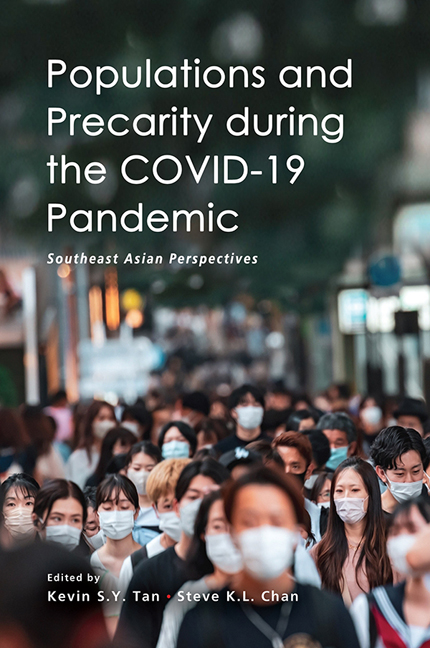Book contents
- Frontmatter
- Contents
- Preface
- About the Contributors
- 1 Introduction: Populations, Precarity and the COVID-19 Pandemic
- 2 Transformation of the Family Structure in Southeast Asia: Trends and Implications
- 3 New Normal, Old Ties: COVID-19’s Social Impact on the Singapore-Johor Bahru Connection
- 4 Unequal Flows: Examining the Factors Surrounding Thai and Vietnamese Labour Migration to South Korea
- 5 Emplacing Multiculturalism: Southeast Asian Migrant Linguistic Acculturation Programmes and Community Building in South Korea
- 6 “Foreign Talent” in Singapore and Some Implications for Schools
- 7 Managing Disaster Risk and Enabling Social Protection in Thailand: Some Lessons from the COVID-19 Pandemic
- 8 Transnational Housing Insecurity: Mobility, Homelessness, and the COVID-19 Pandemic
- 9 Older Persons with Hearing Disabilities in Indonesia: Vulnerability and Demographic Diversity during the COVID-19 Pandemic
- Index
4 - Unequal Flows: Examining the Factors Surrounding Thai and Vietnamese Labour Migration to South Korea
Published online by Cambridge University Press: 01 March 2024
- Frontmatter
- Contents
- Preface
- About the Contributors
- 1 Introduction: Populations, Precarity and the COVID-19 Pandemic
- 2 Transformation of the Family Structure in Southeast Asia: Trends and Implications
- 3 New Normal, Old Ties: COVID-19’s Social Impact on the Singapore-Johor Bahru Connection
- 4 Unequal Flows: Examining the Factors Surrounding Thai and Vietnamese Labour Migration to South Korea
- 5 Emplacing Multiculturalism: Southeast Asian Migrant Linguistic Acculturation Programmes and Community Building in South Korea
- 6 “Foreign Talent” in Singapore and Some Implications for Schools
- 7 Managing Disaster Risk and Enabling Social Protection in Thailand: Some Lessons from the COVID-19 Pandemic
- 8 Transnational Housing Insecurity: Mobility, Homelessness, and the COVID-19 Pandemic
- 9 Older Persons with Hearing Disabilities in Indonesia: Vulnerability and Demographic Diversity during the COVID-19 Pandemic
- Index
Summary
Introduction
Globalization often implies the increased flow of persons, goods and information across country borders. Consequently, labour migration between Southeast Asia and the rest of Asia is part of this trend. This is a unique phenomenon unlike migrant flows between the emerging economies of Asia and developed Western countries. This chapter, therefore, examines the reasons and policy issues surrounding the movement of unskilled migrant workers from Thailand and Vietnam to South Korea. The two countries are of great interest in this regard as they are two of the fastest ageing societies in Southeast Asia, with Vietnam having the youngest population in the region. But demographic numbers on fertility and mortality do not tell the full story, as it is important to examine the role of policies adopted by each country with South Korea's Employment Permit System (EPS), in influencing such flows. The reasons and patterns for such migration are based on empirical data drawn from field observations and interviews.
Methodology
The purpose of this study is to uncover the reasons surrounding the outgoing movement of unskilled migrant workers from Thailand and Vietnam to South Korea, and its impact on population change at the source of migrants. Therefore, the relationship of South Korea's EPS to such migration flows will be examined. This study entailed qualitative research consisting of key informant interviews and archival research. The key informant interviews were conducted in Seoul, Bangkok and Daegu. A Korean labour union, women's NGO, Thai labour migrant NGO as well as one Thai and one Vietnamese migrant worker were interviewed in 2018 and 2019. These interviews enabled the author to examine the situation of documented and undocumented workers in South Korea and the roles that migration intermediaries play in the process. All the interviews were conducted anonymously. For the archival research, censuses and labour migration reports of South Korea, Vietnam and Thailand were reviewed.
Reasons for Labour Migration
Existing migration theories seldom address the transnational movement of labour in connection to demographic factors. At a glance, developing countries with young populations tend to export their excess labour force. Classical push-pull discourse claims that labour surplus in the sending country and labour deficit at the destination trigger the flow in both ways (Lee 1966; Castles and Miller 2009).
- Type
- Chapter
- Information
- Populations and Precarity during the COVID-19 PandemicSoutheast Asian Perspectives, pp. 50 - 67Publisher: ISEAS–Yusof Ishak InstitutePrint publication year: 2023

